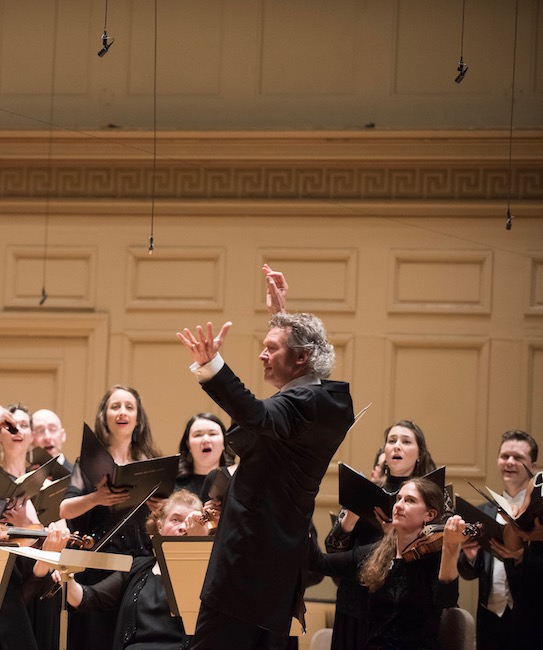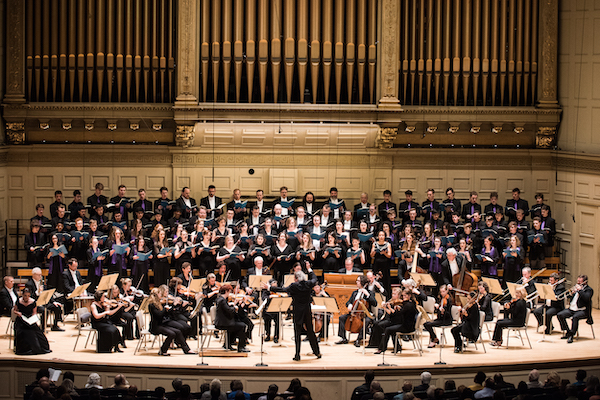Handel and Haydn Society closes season with Bach, Mozart and an Allegri journey

Harry Christophers conducted the Handel and Haydn Society Friday night at Symphony Hall. Photo: Sam Brewer
In 1770, Wolfgang Mozart sat with his father in the papal chapel to hear Gregorio Allegri’s Miserere mei, Deus. Stories about this immaculate setting of chant and polyphony had attracted listeners to Rome for centuries. Louis Spohr heard it, and years later Charles Dickens attempted to enter the Sistine chapel to experience its musical serenity, though he couldn’t deal with the crowds.
The Miserere was less mysterious for its part writing than for its vocal embellishments, musical secrets tightly kept by the singers under threat of excommunication. But the fourteen-year-old Mozart was about to break sacred tradition. After hearing the Miserere once, he made a transcription.
Though his manuscript has not survived, the deed had been done, and new versions of the Miserere soon followed. Charles Burney, the English music historian, published his own independent rendition in 1771 that left out any sense of melodic decoration.
After the Handel and Haydn Society chorus offered a passage from Burney’s version of the score at Symphony Hall Friday night, Harry Christophers turned to the audience and said, “Very plain indeed,” drawing laughter.
As part of their final program of the season, Christophers and his singers took a quick tour through the many editions of Allegri’s seductive piece, highlighting each transformation through demonstration and, eventually, full performance.
With Scott Allen Jarrett conducting, the singers rendered select passages of the Miserere with clarity. The second time through, a vocal quartet, drawn from the choir’s ranks, added subtle dissonances and trickling melismas to their phrases when they answered the full choir. “Much better,” Christophers acknowledged.
The most popular transcription of the Miserere is the so-called “Top-C version,” which features a soaring soprano line. Though stirring when heard live, Christophers reminded the audience that it was not part of the original, stemming instead from a transcription Felix Mendelssohn had made in 1831.
But the full performance of the Miserere, which followed the talkback, combined Mendelssohn’s tasteful, if anachronistic additions as well as elements from every extant version, the music unfolding from simple to more elaborate statements. Leading the singers this time, Christophers drew velvety vocal blend. Chants sung by the men sounded with pristine tone, which the quartet answered with trills and suspensions that culminated on a high C, sung elegantly by soprano Sarah Yanovitch. With all the tranquil qualities of a Renaissance vocal ensemble, the choir brought hushed intimacy to Allegri’s music.
Bach’s Singet dem Herrn, which followed, delivered palpable drama.
Mozart had heard this double-choir motet while visiting Leipzig in 1789. Drawn to its intricately woven lines, the composer reportedly said, “Now, here is something one can learn from.”
With the singers arranged around the orchestra in Friday’s performance, Christophers drew a reading marked by quiet, propulsive energy. Sudden fortes and crescendos brought urgency, and the running lines passed between the choruses rose and fell away. The warm and reverent chorale broke into a brisk fugue that flowered into the final Alleluia. Throughout the performance, the orchestra supplied accompaniment that was felt as much as heard.
That same mix of subtlety and grandeur marked their performance of Mozart’s Requiem, which came after intermission.
Friday’s powerful reading featured a fine cast of guest soloists. In the Tuba Mirum, Soloman Howard’s cavernous bass complemented Tom Randle’s bright, bell-toned tenor. Mezzo-soprano Sandra Piques Eddy sang her lines with a dark, plush tone while soprano Joélle Harvey floated a melody graced with gentle vibrato. Together they sang with delicate blend in the Recordare and with pastoral glow in the Benedictus.
The H&H chorus, filled out with young singers of the Vocal Arts Program, brought visceral excitement to the Dies Irae, pleading intensity to the Kyrie, and searching melancholy to the Lacrimosa. The Confutatis segued between fiery phrases and passages of angelic beauty.
Leading with bold gestures, Christophers mined all the emotional depths from the score, drawing out wide dynamic shading and surging vocal lines marked by crisp, percussive diction. The orchestra, too, followed his lead, forcefully projecting the bright string phrases and brass figures in the “Sanctus.”
Even in Mozart’s Masonic Funeral Music, which opened the concert, the conductor took care to shape every sighing motive and flowing string passage, the music taking on dimension and gravity. Rarely has this orchestra played with such sensitivity and conviction.
The program will be repeated 3 p.m. Sunday at Symphony Hall. handelandhaydn.org; 617-266-3605
Posted in Performances





